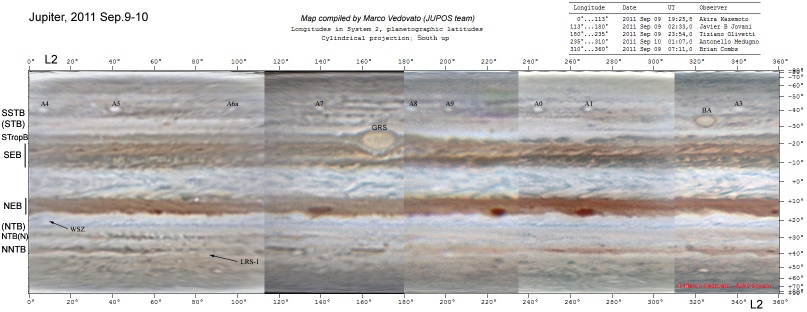
_________________________________
John H. Rogers, Ph.D. Jupiter Section Director,
British Astronomical Association
jhr11@cam.ac.uk
http://www.britastro.org/jupiter/
[1] Jupiter well placed for observing this autumn.
BAA e-bulletin,
2011 Sep.14:
Jupiter well placed for observing this autumn
Jupiter is now rising before midnight for observers in north temperate
latitudes, and climbing higher than it has done since 2003, now being north of
the equator. Moreover, it is close to perihelion, so at opposition on 2011
Oct.29 it will almost equal last year's once-in-a-lifetime proximity.
October oppositions of Jupiter are especially good for northern observers
because of the combination of large disk diameter, high altitude, and a chance
of reasonable weather. The Jupiter
Section welcomes both images and drawings; please see our web site for
guidelines. Already we are receiving first-class images from British and
other European observers, comparable to those from more southerly latitudes in
recent years, showing that top-quality observations can indeed be made from
Europe when the planet is high enough.
At present the planet is settling down after the SEB Revival of 2010 and the NEB
expansion event of 2009. Most regions are comparatively quiet, but of
course there is still plenty of interest to see. The NTB has largely faded
away again, but we want to keep an eye on this almost-blank band, as a new
outbreak of super-fast brilliant spots could erupt at any time. The
NEB carries the most impressive spots: three exceptionally large and dark ovals
('barges'; these are cyclonic circulations), which have developed as the NEB
north edge receded. In the adjacent N.Tropical Zone there are several white
ovals, the brightest being the long-lived White Spot Z.
The SEB is fully revived. White spots (convective storms) were still arising
close to the position of the source of the Revival: at up to L2 ~ 260 in
June, and up to L2 ~ 250 in July. In August they were more subdued and
continued prograding towards the GRS without new outbreaks, though they were
still present as usual following the GRS. The
S.Tropical Zone is largely occupied by a dark grey S.Tropical band, which
emerged from dark material around the GRS as the Revival reached its conclusion.
The STB has two dark sectors, one just preceding the GRS, the other following
oval BA.
Positions and drifts of major long-lived anticyclonic ovals, as of Sep.1, in
System II longitude, are as follows:
Oval BA L2 = 330; DL2 = -15 to -17
deg/month (varying)*
GRS L2 = 168;
DL2 = +0.8 deg/month
WS-Z L2 = 11
; DL2 = -11 deg/month
NN-LRS-1 L2 = 88; DL2 =
-9 deg/month (varying)*
*(Both of these sometimes-reddish ovals are just slightly reddish at present.)
A map is posted here identifying these and other features presently visible.

_________________________________
John H. Rogers, Ph.D. Jupiter Section Director,
British Astronomical Association
jhr11@cam.ac.uk
http://www.britastro.org/jupiter/